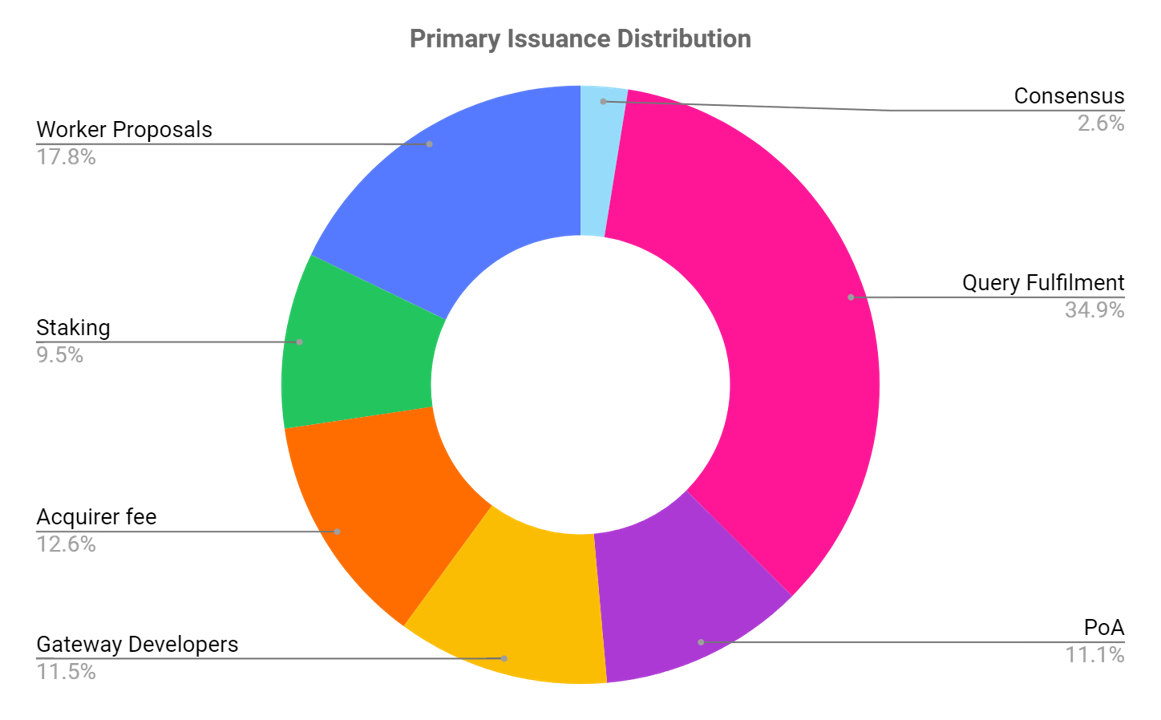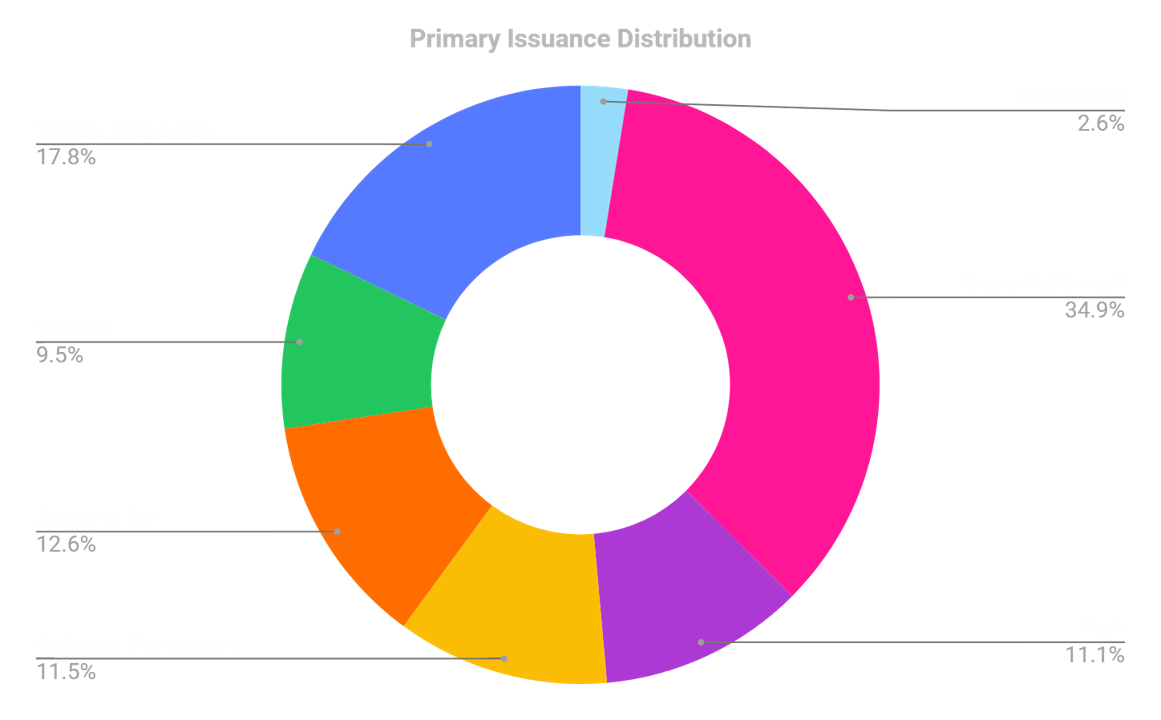Token Distribution


QRY's token distribution aims to establish the right incentives to foster a decentralized ecosystem. The focus is on a fair launch, with no tokens reserved for founders or investors, but open for project backers and operators to participate from the beginning and receive compensation for their efforts. The contract will distribute not only newly minted tokens but also tokens paid as subscriptions and other tokens paid to the QRY engine contract. These tokens will be allocated to various actors to encourage ecosystem growth.
Token distribution will be tuned to incentivize different functions over time and will also adapt to the actual token usage to avoid over supply. Those mechanisms are:
a. Chain Maturity
To adapt to the evolving needs of the network, QRY's token distribution will adjust over time.
-
Early Stages (6 to 12 months): Initially, the distribution will prioritize:
- Proof of Availability: Ensuring providers are consistently online and ready to fulfill requests.
- Staking Incentives: Encouraging users to stake QRY and support the network, with a portion of these incentives used to establish an AMM (Automated Market Maker). This AMM will provide essential liquidity for the QRY token, facilitating easy exchange for both users and providers.
- Worker Proposals: Funding community-driven initiatives that benefit the QRY ecosystem.
-
Mature Stage: Once the network matures and subscription usage increases, token distribution will shift to primarily reward:
- Providers: Those who fulfill queries and ensure data availability.
- Portals: Platforms that drive demand and connect users to the QRY network.
- Integrators: Those who build and maintain integrations with QRY, expanding its functionality and reach.
This dynamic approach ensures that token distribution aligns with the network's growth and incentivizes the most critical functions at each stage of development.
b. Usage Multiplier: A self-stabilizing mechanism designed to counterbalance demand fluctuations
QRY tokens will be issued to pools for each incentivized stakeholder group, the tokens actually distributed by those pools will depend on network usage. Usage will be defined as a function of active subscriptions, token velocity, total value locked (TVL), and other metrics. The low usage ratio indicates the demand for tokens is low, and distribution will be reduced in consequence. On the contrary, when usage is high, the distribution can be even higher than issuance drawing in the pool accumulated during low-demand times.
The stakeholders of the network will receive the issued tokens according to provable on-chain metrics of contribution to the network.
1. Query Fulfillment
Providers will receive the majority of tokens to maintain the necessary infrastructure for responding to queries. They will be rewarded based on their actual usage (Query Fulfillment) and their availability (Proof of Availability — PoA).
The Query Fulfillment pool will be reserved for distribution based on recorded responses to paid subscriptions per Providers, adopting a quadratic distribution of tokens.
This formula determines each Provider's share of the Query Fulfillment pool. It calculates this by taking the square root of the Provider's Total Registered Value (TRV) and dividing it by the sum of the square roots of all Providers' TRVs.
2. Proof of Availability (PoA)
The Proof of Availability (PoA) concept aims to incentivize Providers to keep their services online and accessible at all times. Validators emit challenges that Providers must solve, proving that said Providers are active and serving the queries on the QRY network.
Tokens will be distributed according to staking ranks and availability:
- 85% of the pool will be distributed based on Providers' availability and minimum staking requirements for the services they provide;
- 15% of the pool allocated to top-ranked Validators that chose to register as Challengers, responsible for emitting the challenges.
2.1. Availability Pay (A-Pay)
85% of the PoA pool will be distributed to Providers based on their availability and the minimum staking demanded according to the service they provide. Each Provider claim of this pool can be calculated as follows:
The is the percentage of challenges he answered correctly.
This formula calculates the participation percentage of each Provider () in the 85% pool of Proof of Availability.
- If the observed availability of a Provider is less than 85%, the availability factor becomes 0;
- Else it equals the observed availability of the Provider (percentage of challenges answered correctly).
Dividing the minimum stake of a specific provider by the sum of the minimum stakes of all providers calculates the proportional share of that provider in the context of the entire ecosystem. This calculation is used to determine the relative importance of each provider and helps allocate rewards in a fair and proportional manner. By using the minimum stake as the basis for this calculation, the system ensures that each provider is incentivized to maintain a certain level of commitment and service quality.
The resulting proportion helps distribute resources fairly among providers based on their relative importance and commitment to the network.
2.2. Challenger Pay (C-Pay)
This formula calculates the Challenger Pay (C Pay) for each Validator (Block Producer) participating in the Proof of Availability as a challenger. It first takes 15% of the PoA pool and divides it by N (the number of active challengers) and then multiplies the result by the Activity score of the Provider.
- The Activity score is zero if the Provider registers less than 85% of challenges;
- else it is the minimum of registered challenges (RegChallenges) divided by the Quota, capped at 100%.
where the Quota is the minimum number of challenges that a provider must fulfill within each specified period, as defined in the Gateway code.
3. Integrators
A portion of tokens will be paid to Integrators to incentivize the adaptation of their applications to work with QRY and fund software maintenance and updates.
This formula calculates the participation percentage of each Integrator/Developer () in the Integrator pool. It takes the square root of the total subscription value of the developer and divides it by the sum of square roots of total subscription values of all integrators. In practical terms, this formula serves two main purposes:
1. Mitigating Reward Concentration: The use of the square root function helps to balance returns for Connectors with larger subscription values. This means that as the subscription value of a connector increases, the additional benefit (participation percentage) it gets for each additional unit of subscription value slightly decreases. This helps to prevent large integrators from dominating the rewards pool, thereby promoting fairness in the distribution of rewards.
2. Encouraging diversity: By using this method, smaller integrators are incentivized to participate in the ecosystem as they can still receive a reasonable share of the rewards despite their relatively lower subscription values. This encourages diversity among connectors and fosters a more robust and decentralized ecosystem.
In summary, this formula promotes fairness and decentralization in the QRY ecosystem by ensuring that rewards are distributed more equitably among integrators, regardless of their subscription values. It prevents largely used services connectors from monopolizing the rewards and encourages smaller integrators to participate actively in the ecosystem.
4. Acquirer fee
Client Subscription interfaces (Portals) that register an account during subscription creation will be rewarded with an acquirer fee based on the total amount of QRY paid in subscriptions.
This formula calculates the participation percentage of each portal/platform () in the Referral pool. It takes the square root of the total subscription value of the platform and divides it by the sum of square roots of total subscription values of all platforms.
5. Worker Proposal
A budget for community initiatives will be allocated based on a worker proposal system with governance elected by the community through political playoffs with minimum staking requirements.
6. Staking Rewards
Accounts staking tokens toward Providers will receive a portion of the token distribution, with rewards distributed to various pools with differing maturities to encourage long-term commitment.
7. Consensus
Block Producers that participate in the consensus will be rewarded with tokens, and a stabilization fund will be implemented to manage token liquidity and smooth price trends.